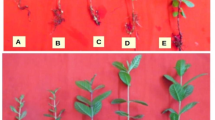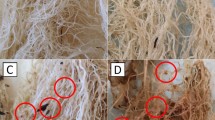Abstract
Outdoor vegetable cultivation is an important economic activity, both for fresh consumption and for the frozen vegetable industry within Flanders, Belgium. In recent years, due to the intensive nature of vegetable cultivation in the open air, nematode problems increased. The quarantine root-knot nematode Meloidogyne chitwoodi causes economic damage to the most important arable crops and vegetables grown in Flanders. However, for some vegetable crops knowledge on host plant status and damage potential is scarce or lacking. The host sensitivity for M. chitwoodi and damage thresholds of the most commonly field-grown cultivars of pea and celeriac were determined, both in glasshouse and field conditions. The damage threshold values (T) for the relative fresh pod weight of pea were 10, 1, 0.2 and 0 J2 (100 cm3 soil)-1 for pea 'Cher', 'Electra', 'Geneva' and 'Pixia' respectively with up to 70% yield loss. For celeriac 'Prinz', the damage threshold was 11.0 J2 (100 cm3 soil)-1 with maximum 22% yield loss. Based on our pot trials, all pea cultivars were considered to be a good host with their high maximum population density (M) and maximum multiplication rate (a) values in the pot trials and reproductive factor (Rf) from the field trials. Celeriac proved to be an excellent host in the pot test but on the field the M. chitwoodi population declined. However, on plots with lowest yield a substantial number of M. chitwoodi was found in the roots. This is the first report of celeriac as host for M. chitwoodi.




Similar content being viewed by others
Data Availability
The datasets used and/or analyzed during this current study are available from the corresponding author on reasonable request.
References
Baermann, G. (1917). A simple method for the detection of Ankylostomum (nematode) larvae in soil tests. Javasche Boekhandel & Drukkerij publishing.
Best4Soil (2023), Best4Soil - Nematode scheme > Nematode scheme (soilhealthtool.eu). Retrieved January 20, 2023, from https://www.best4soil.eu/
Brown, C., Mojtahedi, H., James, S., Novy, R., & Love, S. (2006). Development and evaluation of potato breeding lines with introgressed resistance to Columbia root-knot nematode (Meloidogyne chitwoodi). American Journal of Potato Research, 83, 1–8. https://doi.org/10.1007/BF02869604
Dahl, W. J., Foster, L. M., & Tyler, R. T. (2012). Review of the health benefits of peas (Pisum sativum L.). British Journal of Nutrition, 108, S3–S10. https://doi.org/10.1017/S0007114512000852
Decraemer, W., & Hunt, D. J. (2013). Structure and classification. In: Perry. R.N. & Moens. M. (Eds). Plant nematology. Wallingford. UK. CABI Publishing. pp. 3-39. https://doi.org/10.1079/9781845930561.0003.
den Nijs, L., Brinkman, H., & van der Sommen, A. (2004). A Dutch contribution to knowledge on phytosanitary risk and host status of various crops for Meloidogyne chitwoodi Golden et al.. 1980 and M. fallax Karssen. 1996: an overview. Nematology 6. 303-312. https://doi.org/10.1163/1568541042360492
Ferris, H., Carlson, H., Viglierchio, D., Westerdahl, B., Wu, F., Anderson, C., Juurma, A., & Kirby, D. (1993). Host status of selected crops to Meloidogyne chitwoodi. Journal of Nematology, 25, 849–857.
Golden, A. M., O’Bannon, J., Santo, G., & Finley, A. (1980). Description and SEM observations of Meloidogyne chitwoodi n. sp. (Meloidogynidae). a root-knot nematode on potato in the Pacific Northwest. Journal of Nematology, 12, 319–327.
Hendrickx, G. (1995). An automatic apparatus for extracting free-living nematode stages from soil. Nematologica, 41, 308.
Griffin, G. (1989). Comparison of fumigant and nonfumigant nematicides for control of Meloidogyne chitwoodi on potato. Journal of Nematology, 21, 640–644.
Janssen, G. J., van Norel, A., Verkerk-Bakker, B., & Janssen, R. (1995). Resistance to Meloidogyne chitwoodi. M. fallax and M. hapla in wild tuber-bearing Solanum spp. Euphytica, 92, 287–294. https://doi.org/10.1007/BF00037110
Jaffee, B., & Muldoon, A. (1995). Susceptibility of root-knot and cyst nematodes to the nematode-trapping fungi Monacrosporium ellipsosporum and M. cionopagum. Soil Biology and Biochemistry, 27, 1083–1090. https://doi.org/10.1016/0038-0717(94)00240-2
Jones, J. T., Haegeman, A., Danchin, E. G., Gaur, H. S., Helder, J., Jones, M. G., Kikuchi, T., Manzanilla-López, R., Palomares-Rius, J. E., & Wesemael, W. M. (2013). Top 10 plant-parasitic nematodes in molecular plant pathology. Molecular plant pathology, 14, 946–961. https://doi.org/10.1111/mpp.12057
Karkanis, A., Ntatsi, G., Kontopoulou, C.-K., Pristeri, A., Bilalis, D., & Savvas, D. (2016). Field pea in European cropping systems: adaptability. biological nitrogen fixation and cultivation practices. Notulae Botanicae Horti Agrobotanici Cluj-Napoca 44. 325-336. https://doi.org/10.15835/nbha44210618.
Kornobis, S. (2004). Diversity of Meloidogyne hapla Chitwood, 1949 population in Poland. Russian journal of nematology, 12, 31–38.
Koshy, P., Eapen, S., & Rakesh, P. (2005). Nematode parasites of spices. condiments and medicinal plants. In: M. Luc, R. A. Sikora, & J. Bridge (Eds), Plant parasitic nematodes in subtropical and tropical agriculture(Ed. 2). Wallingford. UK. CABI Publishing. pp. 751-791. https://doi.org/10.1079/9780851997278.0751.
Melakeberhan, H., & Wang, W. (2012). Suitability of celery cultivars to infection by populations of Meloidogyne hapla. Nematology, 14, 623–629. https://doi.org/10.1163/156854112X624186
Miller, P. (1978). Reproduction. penetration. and pathogenicity of Pratylenchus penetrans on tobacco. vegetables. and cover crops. Phytopathology, 68, 1502–1502.
Moens, M., Perry, R. N., & Starr, J. L. (2009). Meloidogyne species–a diverse group of novel and important plant parasites. Root-knot nematodes. 1. Wallingford. UK. CABI Publishing. pp. 483.
Nicol, J., Turner, S., Coyne, D. L., Nijs, L. d., Hockland, S., & Maafi, Z. T. (2011). Current nematode threats to world agriculture. In: J. Jones, G. Gheysen, & C. Fenoll (Eds), Genomics and molecular genetics of plant-nematode interactions. Springer. Dordrecht. pp. 21-43. https://doi.org/10.1007/978-94-007-0434-3_2.
Riga, E., Porter, L., Mojtahedi, H., & Erickson, D. (2008). Pratylenchus neglectus. P. thornei. and Paratylenchus hamatus nematodes causing yield reduction to dryland peas and lentils in Idaho. Plant Disease, 92, 979–979. https://doi.org/10.1094/PDIS-92-6-0979B
Santo, G., & Ponti, R. (1985). Host suitability and reaction of bean and pea cultivars to Meloidogyne chitwoodi and M. hapla. Journal of Nematology, 17, 77–79.
Schomaker, C., & Been, T. (2013). Quantitative nematology and management. In R. N. Perry & M. Moens (Eds.), Plant nematology (pp. 301–330). CABI Publishing.
Statbel.(2022). DBREF-L05-2021-TAB-A-NL.xlsx (live.com), Retrived January 18, 2023.
Vovlas, N., Lucarelli, G., Sasanelli, N., Troccoli, A., Papajova, I., Palomares-Rius, J. E., & Castillo, P. (2008). Pathogenicity and host-parasite relationships of the root-knot nematode Meloidogyne incognita on celery. Plant Pathology, 57, 981–987. https://doi.org/10.1111/j.1365-3059.2008.01843.x
Waeyenberge, L., Viaene, N., & Moens, M. (2009). Species-specific duplex PCR for the detection of Pratylenchus penetrans. Nematology, 11, 847–857. https://doi.org/10.1163/156854109X428016
Wesemael, W., Perry, R., & Moens, M. (2006). The influence of root diffusate and host age on hatching of the root-knot nematodes. Meloidogyne chitwoodi and M. fallax. Nematology, 8, 895–902. https://doi.org/10.1163/156854106779799204
Wesemael, W., Viaene, N., & Moens. M. (2011). Root-knot nematodes (Meloidogyne spp.) in Europe. Nematology. 13(1). 3-16. https://doi.org/10.1163/138855410X526831.
Wesemael, W. M., & Moens, M. (2008). Quality damage on carrots (Daucus carota L.) caused by the root-knot nematode Meloidogyne chitwoodi. Nematology, 10, 261–270. https://doi.org/10.1163/156854108783476368
Wesemael, W. M., & Moens, M. (2008). Vertical distribution of the plant-parasitic nematode. Meloidogyne chitwoodi. under field crops. European Journal of Plant Pathology, 120, 249–257. https://doi.org/10.1007/s10658-007-9213-x
Wishart, J., Blok, V. C., Phillips, M. S., & Davies, K. G. (2004). Pasteuria penetrans and P. nishizawae attachment to Meloidogyne chitwoodi. M. fallax and M. hapla. Nematology, 6, 507–510. https://doi.org/10.1163/1568541042665269
Wishart, J., Phillips, M., & Blok, V. (2002). Ribosomal intergenic spacer: A polymerase chain reaction diagnostic for Meloidogyne chitwoodi. M. fallax. and M. hapla. Phytopathology, 92, 884–892. https://doi.org/10.1094/PHYTO.2002.92.8.884
Acknowledgement
This study was funded by Flanders Innovation & Entrepreneurship (vlaio, contract HBC.2016.0770) and supported by the Belgian Plant Protection Service (FAVV) (agreement 10-ILVOCRA-Planten. We thank Dr. Misghina Goitom Teklu for his advice and guidance in the analysis using the damage threshold and population dynamic models.
Author information
Authors and Affiliations
Corresponding author
Ethics declarations
Competing interests
The authors have no competing interests to declare that are relevant to the content of this article.
Rights and permissions
Springer Nature or its licensor (e.g. a society or other partner) holds exclusive rights to this article under a publishing agreement with the author(s) or other rightsholder(s); author self-archiving of the accepted manuscript version of this article is solely governed by the terms of such publishing agreement and applicable law.
About this article
Cite this article
Taning, L.M., Chann, L., Fleerakkers, S. et al. Host plant status and damage threshold of Pea (Pisum sativum) and Celeriac (Apium graveolens var. rapaceum) for the temperate root-knot nematode Meloidogyne chitwoodi. Eur J Plant Pathol 167, 323–333 (2023). https://doi.org/10.1007/s10658-023-02714-y
Accepted:
Published:
Issue Date:
DOI: https://doi.org/10.1007/s10658-023-02714-y




